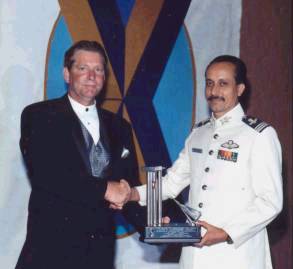The momentous day from 2001, when the LCA took to the air for the first time.
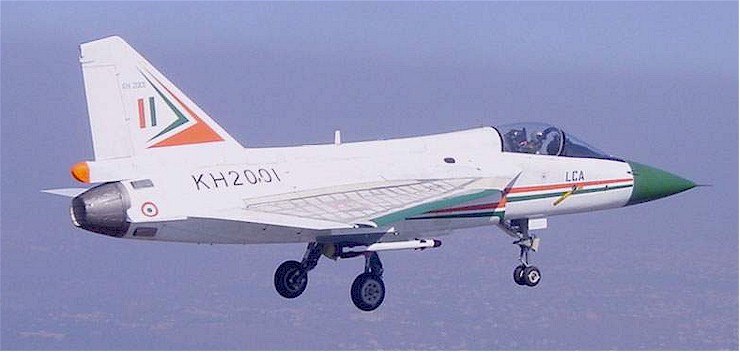
4th January 2001, Wing Commander Rajiv Kothiyal in the cockpit of the TD1 on its first flight – as captured from the chase aircraft
4th January 2001.
I woke up at 5:30 am with a feeling which was a strange mixture of anticipation, confidence and a vague fear of the unknown. A lot was at stake for Indian aeronautics that day. It was the day the Light Combat Aircraft (LCA), Technology Demonstrator-1 was to take to the air for the first time and I, as the man in charge of the flight test programme, was responsible for the safety of the test flight. The telephone rang at 6:30am.. It was Dr Kota Harinarayana, the Programme Director, confirming that the aircraft had completed its pre flight checks and was being towed to the flight line. Though the planned take-off was at 10am, the flight briefing was to start at 8 am. I raced to the National Flight Test Centre (NFTC) located at the HAL/civil airport at Bangalore.
Shortly after I got there, Dr VK Aatre, the Scientific Adviser to the Raksha Mantri and Director-General Aeronautical Development Agency, Dr Kota. and Mr K Nagraj, Chief Executive of the Centre for Military Airworthiness and Certification arrived . I had requested the Chief of the Air Staff (CAS), Air Chief Marshal Anil Tipnis, to be at NFTC by 7:45am for the briefing as he was going to pilot one of the two Mirage 2000 chase aircraft. He arrived five minutes early, and after a quick pre-flight medical for the five pilots involved in the day’s flying, we assembled in the briefing room.
42 year old Wg Cdr Rajiv Kothiyal (Kothi), a graduate of the United States Air Force Test Pilots School, was the pilot chosen for the hazardous mission. Hazardous, not because of negligence on any one’s part, but because of the many new technologies in the aircraft, especially the quadruplex digital fly by wire Flight Control System (FCS) and the “glass” cockpit, both of which had been developed indigenously for the first time.
The briefing began and Kothi did not show any sign of nervousness. In fact he exuded an air of quiet confidence as he described the flight profile and told the crew of the two chase aircraft what exactly he expected of them in the event of an in-flight emergency. We ran through an elaborate list of emergencies that could occur and discussed the action to be taken for each eventuality. Two helicopter crews were also present; one was to be on airborne standby with a doctor on board and one on the ground. The weather was fine with cloudless skies and light winds. Ideal conditions for the first flight of a prototype.
I went with Kothi to the flight line where the aircraft was parked. It was all white as prototype aircraft are usually painted in a high visibility paint scheme for ease of tracking with optical trackers. It looked beautiful and had IAF roundels on its wings and the tricolour flash on the tail fin .The tail number was KH 2001 in honour of Dr Kota Harinarayana, and the year of the first flight.
Though no official announcement of the first flight had been made, HAL and ADA personnel had thronged vantage points on the roofs of surrounding buildings not wanting to miss watching aviation history being made. Kothi finished his walk around inspection of the aircraft and I said “Kothi, we have done our homework well. The flight controls and all systems have behaved perfectly during the ground tests and high speed taxi runs. You shouldn’t have a problem. Best of luck.”
Of course my heart was in my mouth as I spoke but I did not let my feelings show. Dr Kota also came and wished Kothi the very best. A number of VIPs who were not present at the briefing had gone straight to the viewing point by the side of the runway.
I rushed back to the telemetry monitoring control room and positioned myself next to Wg Cdr Raveendran (Ravi), the test director who was in front of the master monitoring console . Ravi was a Flight Test Engineer who had spent six years in the LCA programme. He had profound knowledge of every system on the aircraft. The prototype was extensively instrumented with over 350 parameters being acquired from critical systems and telemetered in real time to the ground station. We had 16 monitors in the room each console manned by a systems specialist keeping a watchful eye on the performance of his or her system. The engine, fuel, hydraulics, electrics, environmental control, brakes, flight control system, vibrations and strains at critical locations on the airframe were being monitored for the flight. Video cameras located with the telemetry antenna gave the test director a good view of the aircraft on the flight line as well as the runway in use and the approach funnel. None of the other specialists could see the video screen and all the curtains were drawn to permit them to concentrate on monitoring the performance of their system and report any anomaly noticed immediately to the test director on the intercom.
Air Marshal J S Rai the Air Officer Commanding-in-Chief, Training Command, IAF walked into the room and sat down next to me. I ordered the door to be closed and looked at my watch .It was 9;15 am. The radio crackled to life and Kothi’s voice came over the air asking Ravi to start the pre-flight checks. Shortly thereafter he started the GE F 404 engine and all the monitoring consoles came alive with system indications. The two Mirage 2000 chase aircraft, the primary chase aircraft piloted by Wg Cdr Raghunathan Nambiar (Nambi), also started up .The after start checks, radio checks with the chase aircraft and the Air Traffic Control (ATC) tower went through without a hitch but took 30 minutes. Only the final hurdle remained.
All aircraft fitted with fly by wire flight control systems have to perform an automatic built in test of the system after engine start. This required a button to be pressed by the pilot after which the flight control computer took over and ran through a pre programmed sequence of tests called PBIT at the end of which a green GO lamp flashed in the cockpit. In an aircraft in service it took about a minute. In a prototype it was more elaborate and took 10-12 minutes. When Kothi initiated the test, I kept my fingers crossed as we had had test failures in the past. A first time failure of the PBIT to pass would call for a repeat of the test. A second time failure would require the test flight to be aborted for the day. The airfield had been closed only for an hour from 10am to11am and it was already 9:47 am. The minutes went by with agonising slowness and after what seemed an eternity, to my great elation I saw the green GO lamp shining on the aircraft’s main instrument console. Kothi asked for taxi instructions from the ATC tower. It was exactly 10 am.
![Click on Image to View Video of LCA taxying [254kb]](https://www.bharat-rakshak.com/IAF/wp-content/uploads/2009/11/LCA-Flight02.jpg) |
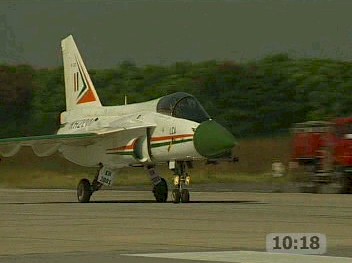 |
| Kothiyal acknowledges by saluting as he starts taxying the LCA out. Click to view the 254KB Video |
The LCA TD1 starts its take off roll |
On the video screen I saw the two Mirages move out of the parking area and enter the taxi track. The LCA followed them. The East facing Runway 09 was in use and Kothi headed for the line up point. It was a glorious sight to behold. Blue skies. bright sunshine and the LCA in gleaming white majestically rolling down the taxi track with thousands of people watching from the rooftops of every building in sight .As the aircraft neared the runway the brake specialist called out a failure of one of the two control lanes available in the brake by wire system. Ravi looked at me for a decision and I flashed him a thumbs up sign as I was aware of the redundancies available to bring the aircraft to a stop on the landing roll. After a final check of the aircraft by the wheels and tyres check team Kothi took permission and entered the live runway.
The two Mirages were airborne by this time, but Kothi could roll only when Nambi gave him a radio call to do so indicating that he was correctly positioned to effect a quick join up with the prototype after it got airborne.
Kothi opened full power on the engine and did a final check of the flight controls. All 16 specialists confirmed to Ravi that all systems were GO and Ravi cleared Kothi to roll. Nambi’s call came and Kothi released brakes. I saw the aircraft accelerating rapidly down the runway. Kothi called “Rotating” and raised the nose wheel. Seconds later the LCA lifted off gracefully. It was 10;18 am. The next few seconds would tell us whether the years of toil Team LCA had put in developing the FCS would come to naught or not. Kothi’s call “And climbing” set those fears at rest as we now knew the FCS was working as it should.
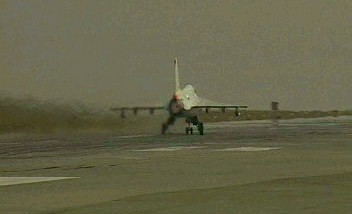 |
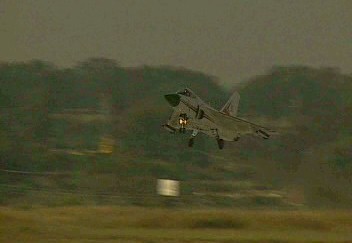 |
| “Rotating” Kothiyal transmits on the R/T before lifting the nose Click to view the 261KB Video |
“..and climbing..” as the LCA TD1 leaps into the air Click to view the 208KB Video |
I was just about to begin breathing normally when the telemetry auto tracking system failed and all 16 screens started showing erroneous readings. There was no way of knowing what was happening in the innards of the aircraft! Ravi said “Shall I call him back?” Chase aircraft are provided to enable the test team to cope with such eventualities. I said “Tell Nambi to move into close formation and check the aircraft for fuel and hydraulic leaks or other signs of abnormal behaviour”. Kothi said that his cockpit readings were fine and the aircraft was flying normally. Nambi reported no sign of any abnormality. I decided to continue with the planned flight profile and told Ravi to inform the pilot of my decision. Kothi agreed with me and continued with the flight. I aged a lot in those few seconds!
The flight profile called for a climb to3 km (10000 feet), a slow down to approach speed, a practice circuit at that height, some gentle turns and a return to base. The wheels were left in the down and locked position through out as aircraft wheels are the only known objects in the physical world which do not obey Newton’s law of gravitation! Sometimes they go up and don’t come down and we did not want that kind of excitement on the first flight!!
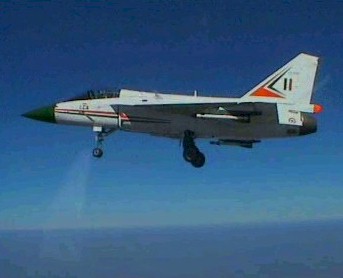 |
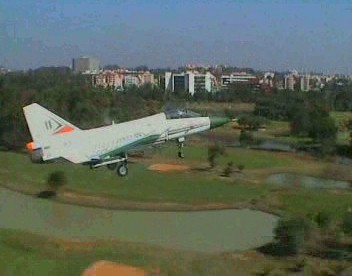 |
| The LCA TD1 on its first flight with its Undercarraige down Click to view the 216KB Video |
Appraoching the HAL Runway for landing Click to view the 228KB Video |
Kothi flew the planned profile and said the aircraft was behaving more or less in the same way as it did in the simulator on which he had practiced the profile over and over again for the past few weeks. It was soon time to land and Kothi positioned himself on a 10 km long straight in approach to Runway 09. When he was about three minutes away on approach the telemetry antenna locked on to the aircraft and data reappeared on the screens. Ravi asked the systems specialists to confirm all was normal and to my great relief and everyone else’s they reported all systems were GO.
We saw the LCA with the two Mirages escorting it appear on the video screen .It was a sight which will remain etched in my memory for the rest of my life. Everyone tensed up as the crucial first landing was about to take place. Kothi’s voice remained calm when he asked ATC for landing instructions. He flew a steady approach, flared the aircraft over the runway and executed a flawless touch down on the main wheels. He lowered the nose wheel on to the runway and deployed the tail chute. The Mirages came down low and did a go around. As the aircraft slowed down to taxiing speed, he jettisoned the chute and turned off the live runway. The time was 10;36 am. The first flight had lasted only 18 minutes but heralded a renaissance of Indian aeronautics that will enable this country to assume its rightful place amongst the aeronautical powers of the world in the years ahead.
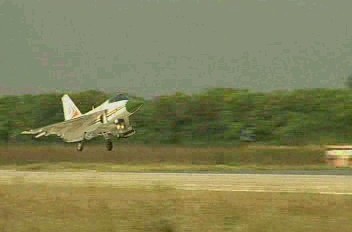 |
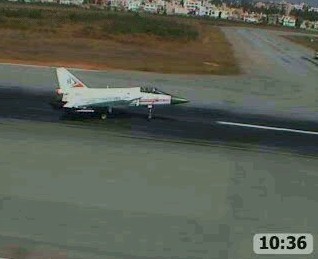 |
| The LCA just before landing on the runway. Click to view the 228KB Video |
The Mirage chaseplane view of the LCA landing on the runway Click to view the 201KB Video |
As Kothi parked the aircraft and switched off the engine, there were wild scenes of jubilation amongst the HAL and ADA personnel. Someone even held the Tricolour aloft symbolising a moment of national pride. When Kothi came down the ladder he was mobbed by the workers and carried on their shoulders for some distance. A huge gathering of VIP’s thrust their way forward each one intent on marking his presence in the photographs which were being shot by the hundreds. After considerable effort I was able to go up to Kothi and shake his hand! At the debriefing session the room was crowded with the who’s who of Indian aeronautics. Kothi was congratulated by the Raksha Mantri Shri George Fernandes and the CAS. We looked at the video camera footage shot from the chase aircraft and the data captured on the telemetry screens during the all important take-off and landing phases of flight. Every system on board the aircraft had worked perfectly. It is a mandatory requirement in test flying to list out all anomalies noticed from engine start to shut down to enable the designers and technicians to take remedial action and clear the aircraft for the next test flight. When Kothi filled in the snag sheet he wrote “Nil snags”. There could have been no more fitting tribute to the professionalism , industry and dedication of Team LCA and it was my privilege to have been part of that team.
Later that day I ordered an investigation into the telemetry problem. It turned out to be a software technology park in Bangalore using the precise frequency on which the LCA telemetry signal was being transmitted. The telemetry auto track antenna had locked on to the signal as it was stronger than that of the LCA. We were blissfully unaware of this misuse of our frequency!!
After Kothi had flown the first six flights I sent his nomination for the prestigious Iven Kinchloe Award to the Society of Experimental Pilots (SETP) in the US. The SETP gives this award every year for the most significant achievement in experimental test flying during the year under consideration. Very few in India seemed to have realised the significance of the achievement of safely flying a prototype with so many new technologies on board.
|
|
| Wg Cdr Rajiv Kothiyal receiving the Kincheloe award from Iven C. Kincheloe IV at SETP. Photo Courtesy: www.setp.org |
The SETP awards committee which consisted of a group of very experienced test pilots who had seen many programmes world wide thought differently and had no hesitation in giving the Iven Kinchloe Award for the year 2001 to Rajiv Kothiyal .I was very happy that Team LCA’s monumental effort had been recognised by a bunch of hard nosed professionals. No Indian test pilot had ever received this award in the past..
Recommended Links:
1. The Aeronautical Development Agency’s Official Website.
2. LCA Pilot Rajiv Kothiyal – page on ADA Website
3. Ivan C Kincheloe award to Indian Test Pilot SETP page on the award (web.archive.org backup link)
